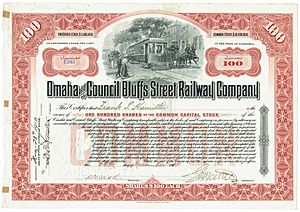Omaha and Council Bluffs Railway and Bridge Company facts for kids
| Industry | Public transportation |
|---|---|
| Fate | Merged |
| Successor | Omaha Traction Company |
| Founded | 1886 |
| Defunct | 1955 |
| Headquarters | Omaha and Council Bluffs |
|
Key people
|
George F. Wright, Gurdon Wattles |
The Omaha and Council Bluffs Railway and Bridge Company, often called O&CB, was a big company started in 1886. Its main goal was to connect Omaha, Nebraska and Council Bluffs, Iowa. They did this by building a bridge over the Missouri River.
The O&CB had special permission to be the only company running streetcars in these two cities. It was one of the first major electric streetcar systems in the United States. The O&CB was also one of the last streetcar companies to operate in the U.S. Its final streetcar ride happened in 1955.
How the O&CB Started
The company that came before the O&CB was the Omaha Horse Railway Company. This company was created in 1867 by a law from the Nebraska Legislature. Electric streetcar service in Omaha grew from the Omaha Motor Railway, which began in 1887. This happened when the Omaha Horse Railway and the Omaha Cable Tramway Company joined together. Samuel D. Mercer led this new company.
George F. Wright helped start the Omaha and Council Bluffs Railway and Bridge Company in 1886. He had also built the Council Bluffs Street Railway company in 1868. Other important people involved were Frank Murphy, Guy C. Barton, John T. Stewart, and Thomas J. Evans.
Big investors, called stockholders, included Marshall Field from Chicago. U.S. Senator Joseph Millard of Nebraska and officials from the American Smelting Company also invested. The last horse car route in the city stopped running in June 1895.
The Douglas Street Bridge
The O&CB wanted to build a bridge over the Missouri River. This bridge would carry both wagons and railway cars. The United States Congress and the Secretary of War approved their plan in 1887.
This approval led to the building of the Douglas Street Bridge. This bridge later became known as the Ak-Sar-Ben Bridge. It opened for people and vehicles on October 30, 1888.
How the Streetcars Operated
After building the bridge, the O&CB created streetcar lines all over Omaha. These lines reached suburbs like South Omaha, Benson, Dundee, and Florence. In 1888, George F. Wright became the company's Secretary. The O&CB then built the first electric street railway line ever in Iowa or Nebraska.
In 1898, the Omaha Street Railway, which the O&CB later bought, prepared for the Trans-Mississippi Exposition. They ordered new streetcars and fixed older ones. They also spent $100,000 to improve the streetcar system. This included making their power plant at 20th and Nicholas Streets stronger.
By 1902, all electric railways in Omaha were combined under the O&CB. That same year, a group of investors from New York City bought the company for $4,000,000. They took control of all its shares.
The Omaha and Council Bluffs Street Railway Company bought the Omaha and Council Bluffs Railway and Bridge Company in 1902. They signed a 100-year agreement to use the city's railway tracks. This company also took over other local transport businesses. These included the Omaha Street Railway Company and the Council Bluffs Street Railway Company.
Later, a local banker named Gurdon Wattles bought the company. He combined it with several other competing lines. He created a new company called the Omaha Traction Company. At this point, the O&CB stopped being an independent company. However, Wattles continued to use the O&CB name.
During World War II, many male streetcar drivers joined the military. In 1943, the company started training women to be streetcar operators. The women learned quickly and earned the same pay as the men.
In the late 1940s, the O&CB faced a protest. The DePorres Club, a youth-led group in Omaha's civil rights movement, organized a boycott. They protested the railroad's unfair practices and poor service in the Near North Side neighborhood. This protest happened four years before the famous Montgomery bus boycott.
The Omaha and Council Bluffs Street Railway Company Car Barn is still standing today. It is located at South 10th Street and Pierce Street. This was the last active car barn in the city. The O&CB streetcar line stopped running on March 4, 1955.
The Car Barn at South 10th Street and Pierce Street was later used by the United States Postal Service. There are plans to fix up this building soon.
There is also a Sub-Station still standing in Council Bluffs, Iowa. One streetcar is kept on freight car wheels at South 11th Street and Leavenworth Street in Omaha. Another streetcar, without its wheels, is kept inside the Durham Western Heritage Museum at 801 South 10th Street in Omaha. Also, part of a streetcar body is used as a cabin off Allied Road in Bellevue, NE.
Images for kids



